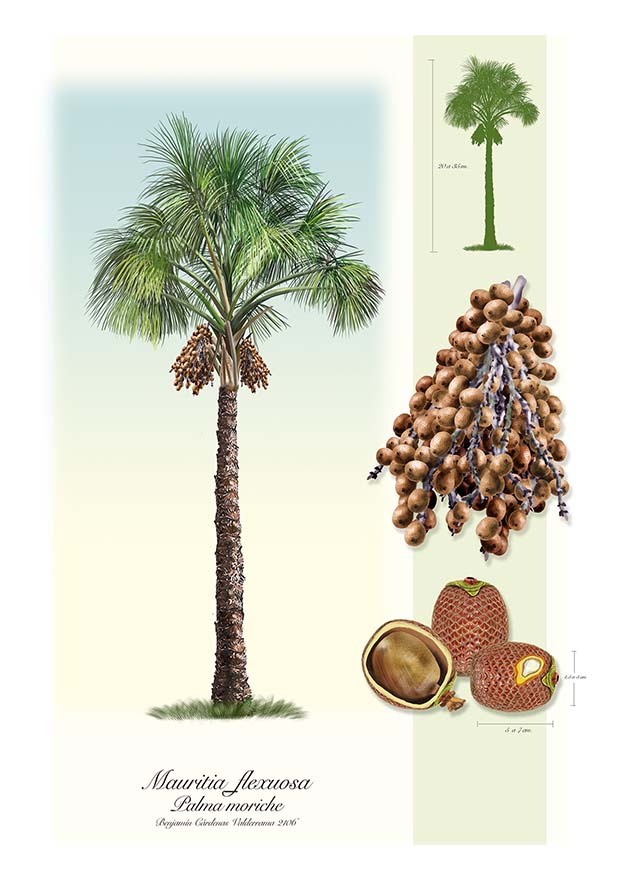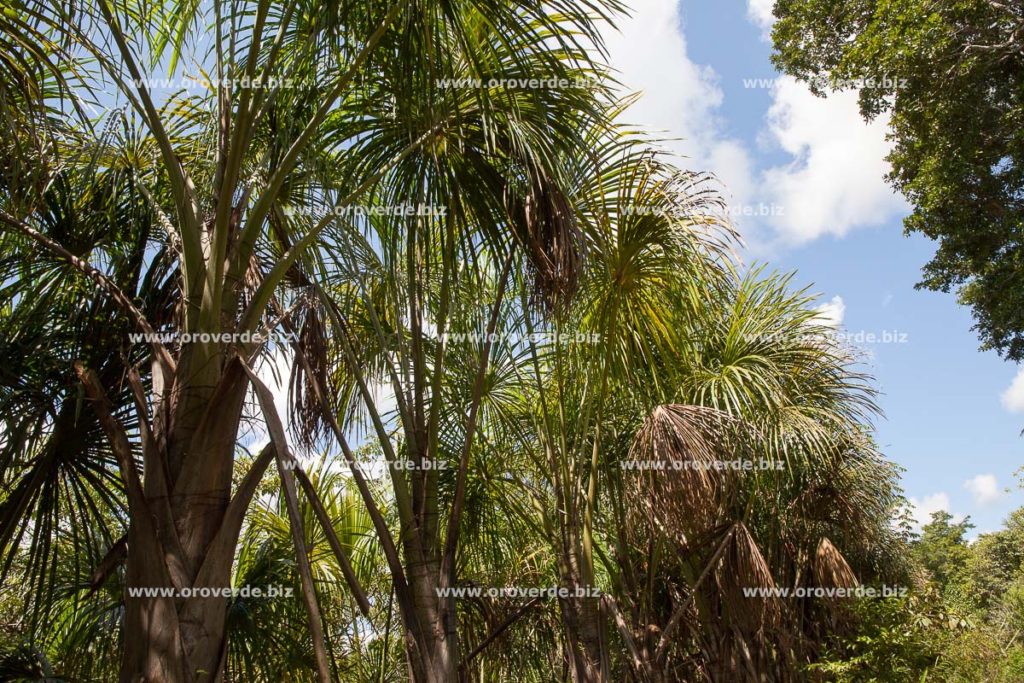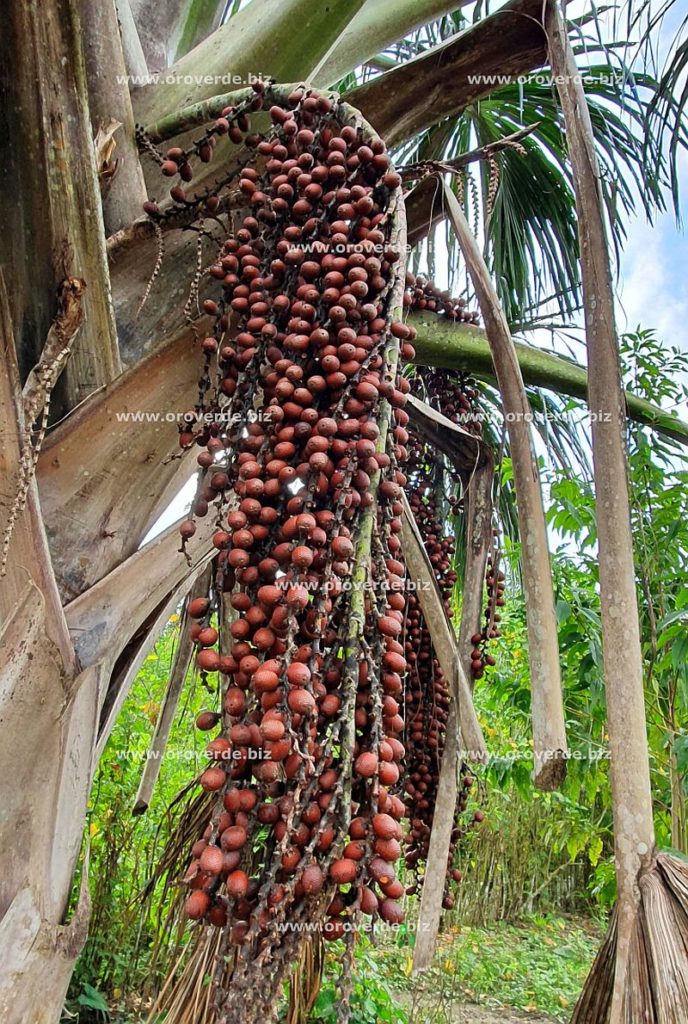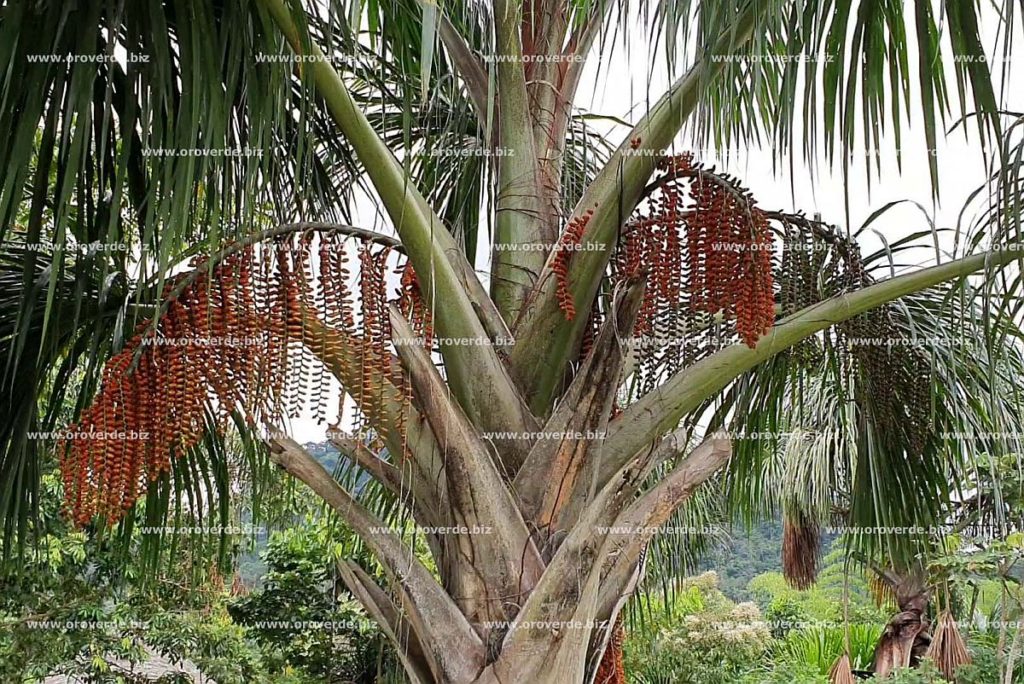It affects the following diseases:
Family: Arecaceae
Genus: Mauritia
Species: flexuosa L.
Synonyms : Mauritia minor Burret, M. sagus Schult.&Schult.f., M. setigera Griseb&H.Wendl. , M. sphaerocarpa Burret, M. vinifera Mart., Saguerus americanus H.Wendl.
Native names : Aguaje, moriche, ité, ita, buriti (Brasil), muriti, canangucho (Colombia)
Used part of plant : fruit
Description:
The aguaje palm (the indigenous names aguaje, moriche, morete, palm ité, buriti) is one of the most widely used multi-purpose palms in the tropical rainforest of South America. He prefers permanently or at least periodically flooded localities, mostly occurring here in groves and stands called aguajal (read aguachal). It grows freely, due to its popularity it is often grown. In the productive age, which begins 7-8 years of life of the palm tree, the harvest is between 20-28 tons per hectare per year, while the life of the palm tree is around 45-50 years.
It is very popular among the natives of Amazonia, and in reverence, it is not for nothing that they call it the “sacred palm of life”.
It is a polygamously dicotyledonous tree from the areca family (usually referred to as palms), ie it forms separate individuals with male, female or also bisexual flowers. The crown is spherical, in natural conditions it usually grows to a height of 10-30 m, often but also up to 60 m. The trunk is straight, columnar, smooth whitish gray in the lower and greenish in the upper part, with indistinct rings on fallen leaves, diameter 35 – 60 cms. The primary roots grow to a depth of 60 cm and then branch horizontally up to 40 m in length. In addition, they form secondary aboveground pneumatomorphic roots that allow nutrition in hydromorphic conditions.
From the top of the trunk grows on arched curved petioles 10-20 palmately pinnate, 5 to 6 meters long leaves. The deeply grooved petiole of dark green color grows up to 4 m long. The 1-2 meter long leaf spindle is divided into 110 – 130 narrow blades on the upper side of dark green and on the lower side of light green color. The leaf blades are bifurcated at the end, which creates a spatial impression.
Male and female inflorescences have the same size and shape, they are interfoliary (ie they grow from the axils of wooden leaves). They form 25-40 side branches and grow to 2-3 meters in length. 2-8 inflorescences grow from the crown of the tree in this way.
Triple flowers are relatively small, male significantly larger than 10 x 7 mm, growing in pairs, in contrast, female flowers only 2 mm long. Pollination is provided mainly by insects and bees, sometimes there is also pollination by the wind. Outside the flowering period, it is not possible to distinguish between male and female individuals.
The fruit is a variable spherical or ellipsoidal single-seed stone (similar to a hen’s egg) 5-7 cms long and 4-5 cms in diameter, weighing 40 to 85 grams. The outer layer (epicarp) is scaly, hard, dark red to brown in color. The middle layer (mesocarp) is starchy oily, yellow, yellow-orange to reddish in color, only 4 to 6 mm thick. This layer is edible. It makes up 10-21% of the fruit’s weight. The inner layer (endocarp) directly enclosing the stone is mucous. The stone is very hard and makes up 40-44.5% of the fruit’s weight. One inflorescence develops a grape-shaped fertility that weighs up to 40 kg. On average, one tree produces 100-200 kg of fruit per year. The trees begin to bear fruit at about 8 years and the productive age is between 40-50 years.
With its habitat, it ranks among the skeletal trees of the upper middle floor of the tropical rainforest. The palm tree and the multiplicity of uses were described as early as 1846 by the Czech botanist J.S. Presl, “The tree itself feeds on the outflow of the Orinoco River by the unconquered Guarani people, who know how to spread from one trunk to another the river is flooded, they live like monkeys on the tops of trees. These raised dwellings are partly covered with clay. Women light a fire on them for domestic needs, and wandering on the river at night they swim, they see the flames fluttering to great heights. ”This are the words of a Czech botanist, to whom botanical specimens from his travels in the Amazon were sent by a friend Berchtold von Ungarschütz.
The fruit is used for consumption, specifically its flesh. Although it is not easy to remove a scaly shell similar to a shell without damaging only a few millimeters thick flesh, the fruits of aguaje are very popular with the natives. It is estimated that in the Peruvian city of Iquitos alone (about 400,000 inhabitants), about 20 tonnes are consumed per month.
It is sought after especially by women who have experience with the effect of fruits on the formation of the female figure. Thanks to the content of phytoestrogens, the level of female sex hormones is harmonized, and this is reflected not only in the correct distribution of subcutaneous fat, so the fetus “shapes” the female figure into graceful curves.
Various studies demonstrate and clarify the important place of agua fruit in the diet of the Amazon natives. The fruit is rich not only in the content of unsaturated fatty acids, it also contains a high content of tocopherols and carotenoids, the highest of which is ß-carotene, a precursor of vitamin A. It is converted to the target metabolite, vitamin A with the highest efficiency the presence of lipids that promote absorption in the small intestine, the fetus primates in the content of an effective source of provitamin A, without the need for further modifications. According to various sources, aguaje fruits contain up to 10 times more ß-carotene than Daucus carota root, ie carrots.
A study conducted in 2013 with aguaje oil (oil extract) showed antiplatelet activity and the prevention of plaque formation in the vessel walls, which was comparable to aspirin.
You can read the Brazilian studies performed on the ingredients, proving the unique composition of the Mauritia flexuosa fruit here:
Composition and content of tocopherols (μg x g-1) and in the analyzed fruits and seeds of selected Brazilian fruits

a= Values expressed as mean ± standard deviation (n = 9).
b α -TE = Equivalent of α-tocopherol
c ND = not determined
Total content of minerals and trace proverbs in the pulp of aguaje

The antioxidant and chemoprotective activity of aguaje fruits has been independently demonstrated by studies by Cas et al., 2007 and Canud et al., 2010 aimed at inhibiting lipid peroxidation by scavenging free radicals, Oliveira et al., 2013 by studying the antioxidant potential of 6 different flavonoids contained in the fruit. aguaje, Milanez et al. (2016) measured the antioxidant activity of the fruit pulp by two methods: ORAC and DPPH, which observed the highest antioxidant activity between 210 and 240 d anthesis.
As described, the presence of phenols in the fruit pulp was determined. (Bataglion et al., 2014). Phenolic compounds are an important group of natural antioxidants. They can provide beneficial effects against diseases directly or indirectly related to oxidative stress, including cancer, inflammation, diabetes, cardiovascular or neurodegenerative disorders (Nwosu et al., 2011).
Antiplatelet and antithrombotic activity. The pathogenesis of cardiovascular disease is platelet aggregation as a primary phenomenon (Michelson, 2010). Therefore, consumption of mono- and unsaturated fatty acids is associated with a reduced risk of cardiovascular events such as hyperlipidemia, cerebrovascular accident and heart attack. This may correlate with the anti-inflammatory effect of these fatty acids and consequently with a reduction in platelet activation and oxidatively damaging effects of reducing the coagulation cascade (Lin et al, 2016). In vitro assays performed with M. flexuosa and platelet oils were shown to inhibit thrombin-induced P-selectin expression and ATP secretion. Some studies have also shown (a) reduction of thrombus formation by inhibiting platelet adhesion and interaction in the presence of collagen and (b) reduction of platelet-leukocyte interaction, an important step in activating the coagulation cascade and platelet thrombus formation. For this reason, it is appropriate to consider that aguaje oil may be included in the diet as a means of preventing platelet aggregation and thrombogenesis (Fuentes et al., 2013).
Antimicrobial activity. Methanolic extracts of M. exuosa are rich in phenolic compounds, especially chlorogenic acid and caffeic acid, which show immunomodulatory and antimicrobial effects (Koolen et al., 2013b). This substance inhibits the transcription of nuclear kappa factor B (NFκB) and also has temporal activity (Armutcu et al. 2015). Similar bioactivations were also found with quercetin presented in buriti pulp. (Koolen et al., 2013a) demonstrated the antimicrobial potential of methanolic extracts of plant parts against Staphylococcus aureus, Pseudomonas aeruginosa, Escherichia coli, Micrococcus luteus and Bacillus cuteus.
Antitumor effects in vitro. Chemotherapy often presents major side effects and resistance in cancer patients, so it is necessary to look for new alternatives with antitumor potential. Plants have a long history in medicine, are an excellent source of new chemicals (NCE) that exhibit antineoplastic activity, such as some phenolic compounds (Ferreira et al., 2011b, 2016a), especially quercetin present in fruits (Bataglion et al., 2014 )). Some extracts from M. flexuosa showed cytotoxic activity against 5 human tumor cell lines (leukemia, colorectal cancer and breast cancer) with similar results as the positive control used (doxorubicin and cisplatin). Of all the extracts and fractions tested, only tumor cell lines that showed IC50 values ranging from 20.3 to 79.0 μg / ml (Siqueira et al., 2014) were active, only dichloromethane extracts from leaves and stems. A new triterpene called mauritic acid was discovered in the root of M. fl exuosa. It showed significant cytotoxic effects against OVCAR-8 (ovarian), PC-3M (prostate) and NCIH-358M (pulmonary bronchoalveolar) cancers with IC50 values of 3.0, 2.4 and 6.2 μM (Koolen et al., 2013b )
Hypolipemic property. Disorders of lipid metabolism are major factors in cardiovascular and metabolic diseases. Natural substances can regulate lipid metabolism and provide sources of drugs to reduce fat levels (hypolipemics). Methanolic extracts from different parts of M. flexuosa (leaves, stem fruits) contain a significant amount of phenolic compounds, Koolen et al., 2013a, points mainly to the high content of chlorogenic acids and protocatechuic acids mainly in the fruits. Caffeic and chlorogenic acid reduced fatty acid synthesis by inhibiting HMG-CoA reductase (3-hydroxy-3-methylglutaryl coenzyme A) reductase), suggesting that these substances have biological effects on lipid metabolism and weight-related hormones (leptin and adiponectin). (Cho et al., 2010). A study in which a group of laboratory rats were fed a diet containing crude or refined buriti oil showed that the animal feed with refined oil showed a reduction in total cholesterol (60.27%), low-density lipoproteincholesterol (LDL-C, 64.75%). , triglycerides (55.47%) and aspartate aminotransferase (AST) levels (21.57%) compared to the crude oil group. Some phytochemical analyzes have shown that even crude oil extracted from M. flexuosa has high levels of phytosterols, vitamins, antioxidants and pigments (Aquino et al., 2012a, 2015; Milanez et al., 2016), substances often associated with cholesterol reduction. On the other hand, crude oil also contains compounds and impurities (peroxides and hydroperoxides, volatiles and non-volatiles) associated with increased dyslipidemia, hypertension, oxidative stress, endothelial dysfunction and atherosclerosis (Ng et al., 2014).
Hypoglycemic activity. Phenolic compounds are able to improve the glycemic profile and increase or regulate glucose tolerance (Case et al., 2007; Bataglion et al., 2014). Protocatechic acid (PCA), found in aguaje fruits, showed hypoglycemic potential (Bataglion et al., 2014)). Studies suggest that the intake of specific bioactive compounds, such as protocatechuic acid, may have beneficial clinical effects on adipose tissue due in part to their anti-inflammatory and insulin sensitizing properties. PCA has been shown to protect insulin resistance using human adipocytes in vitro as a cellular alarm (Lee et Jeon, 2013; Bataglion et al., 2014; Scazzocchio et al., 2015).
Effects of retinol and tocopherol. A study by Aquino et al. (2015) in young rats showed that serum levels of hepatic retinol and tocopherol were two to three times higher in the aguaa oil consumed group compared to the control group. Medeiros et al., (2015) also showed that burit oil increases serum and liver retinol levels in newborn rats when mothers consumed aguaje oil during lactation.
Potential prebiotic. Polysaccharides play a crucial role in palm fruit, so data on the chemistry of polysaccharides are essential for understanding the nutritional and metabolic aspects of fruit. Polysaccharides exhibit a variety of activities in mammals, including viscosity in the gastrointestinal tract, fermentation, probiotic effects, glucose, lipid, and mineral absorption (Elleuch et al., 2011; Silva et al., 2014). Because the fiber is not absorbed, it reaches the large intestine, where it provides a substrate for intestinal bacteria. Soluble fibers are usually fermented rapidly, while insoluble fibers are slow or only partially fermented. Fermentation is performed by anaerobic colonic bacteria (such as the genera Lactobacillus and Bi-dobacterium), which results in the production of lactic acid, short-chain fatty acids and gas. As a result, the pH in the lumen is reduced, which stimulates the proliferation of colon epithelial cells (Silva et al., 2014).
In October 2012, the author Lukáš Huml published an article in the magazine Vesmír 91, from which we quote: “Aguaje has been attracting the attention of experts for several decades. An interesting study was published, for example, in 1989 in the American Journal of Clinical Nutrition. It describes the reversal of mild xerophthalmia (ed. Note: drying of the cornea and conjunctiva of the eye in vitamin A deficiency and restoration of hepatic vitamin A stores in a group of 44 Brazilian children who received sweets prepared from aguaje pulp for 20 days. As a species that is able to grow on poor soils with poor drainage, where it is difficult to grow other crops, Mauritia flexuosa is an interesting alternative in terms of its nutritional values, possible processing technologies, but also population dynamics. “A long-term solution to vitamin A deficiency in the tropics. However, its potential, like most Amazonian species, is still largely untapped.”
Contraindications: Consumption in large quantities is not recommended for men
Side effects: Not described
Phytotherapeutic properties:
(Ethnomedicinal use) Anticoagulative, antithrombotic, antiphlogistic, dietary, harmonization of female hormone levels
Phytochemical composition:
Carotenoids: α-carotene, ß-carotene, lutein, cis-γ-carotene, trans-γ-carotene, cis-δ-carotene, cis α-carotene, Σ-trans-ß-carotene, 9-cis- ß-carotene, Vitamin E, tocopherols: α-tocopherol, ß-tocopherol, δ-tocopherol, γ – tocopherol, Vitamin C, Phenols: quinic, caffeic, chlorogenic, ferulic, p-coumaric, protocatechic, Flavonoids: catechin, ( -) epicatechin, luteolin, apigenin, myricetin, campferol, quercetin, tricine-7-O-rutinoside (leaf), isoschaftoside (leaf), nicotin fl orin (leaf), rutin (leaf), orientin (leaf) isoorientin (leaf), fatty acids: arachinodic, elaidic, linolenic, linoleic, margaric, myristic, oleic, palmitoleic, palmitic, stearic, Phytosterols: stigmasterol, ß-sitosterol, campesterol, stigmastane-3,5-diene
Source:
DA COSTA, P.A.a; BALLUS, C.A.a; TEIXERA-FILHO, J.b; TEIXEIRA GODOY, H.a Phytosterols and tocopherols content of pulps and nuts of Brazilian fruits
a Department of Food Science, Faculty of Food Engineering, University of Campinas (UNICAMP), P.O. Box 6121, 13083-862 Campinas, SP, Brazil
b Department of Water and Soil, Faculty of Agricultural Engineering, University of Campinas (UNICAMP), P.O. Box 6011, 13083-970 Campinas, SP, Brazil
publikováno v Food Research International 43 (2010) 1603–1606
FUENTES, E.; RODRIGUEZ-PEREZ, W.; GUZMÁN, L.; ALARCÓN, M.; NAVARRETE, S.; FORERO-DORIA, O.; PALOMO, I. Mauritia flexuosa Presents In Vitro and In vivo Antiplatelet and Antithrombotic Activities, publ. https://www.ncbi.nlm.nih.gov/pmc/articles/PMC3878763/
PAITÁN FLORES, S. CULTIVO DE FRUTALES NATIVOS AMAZONICOS, GEF, PNUD, Iquitos, Perú, 1997, 337 s.
PEREIRA FREIRE, J.A. Phytochemistry Profile, Nutritional Properties and Pharmacological Activities of Mauritia flexuosa publ. in Journal of Food Science 81(11), November 2016 DOI: 10.1111/1750-3841.13529














